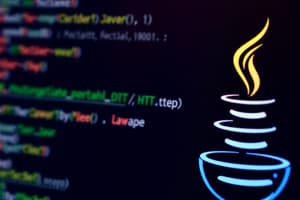Podcast
Questions and Answers
Java was initially called ______, but was renamed Java in 1995.
Java was initially called ______, but was renamed Java in 1995.
Oak
In Java, a special kind of program, the ______, is designed to be transmitted over the Internet and automatically executed by a Java-compatible web browser.
In Java, a special kind of program, the ______, is designed to be transmitted over the Internet and automatically executed by a Java-compatible web browser.
applet
Instead of executable code, the output of a Java compiler is ______, which is executed by the Java Virtual Machine.
Instead of executable code, the output of a Java compiler is ______, which is executed by the Java Virtual Machine.
bytecode
The ______ model characterizes a program as a series of linear steps, with code acting on data, similar to how procedural languages like C function.
The ______ model characterizes a program as a series of linear steps, with code acting on data, similar to how procedural languages like C function.
The two paradigms related to govern how a program is constructed are code and ______.
The two paradigms related to govern how a program is constructed are code and ______.
An essential element of object-oriented programming is ______, which helps in managing complexity using hierarchical classifications.
An essential element of object-oriented programming is ______, which helps in managing complexity using hierarchical classifications.
______ is the mechanism that binds code and the data it manipulates, keeping both safe from outside interference and misuse.
______ is the mechanism that binds code and the data it manipulates, keeping both safe from outside interference and misuse.
In Java, the basis of encapsulation is the ______, which defines the structure and behavior shared by a set of objects.
In Java, the basis of encapsulation is the ______, which defines the structure and behavior shared by a set of objects.
______ is the process by which one object acquires the properties of another object, supporting the concept of hierarchical classification.
______ is the process by which one object acquires the properties of another object, supporting the concept of hierarchical classification.
______, meaning 'many forms', is a feature that allows one interface to be used for a general class of actions, with the specific action determined by the nature of the situation.
______, meaning 'many forms', is a feature that allows one interface to be used for a general class of actions, with the specific action determined by the nature of the situation.
A key feature in using functions in POP (procedure oriented programming) is to ______ a prodecedure, we have to write its name.
A key feature in using functions in POP (procedure oriented programming) is to ______ a prodecedure, we have to write its name.
Examples of procedural oriented programming languages are ______ programming language.
Examples of procedural oriented programming languages are ______ programming language.
The JDK (Java Development Kit) provides the environment to ______ and execute(run) the Java program.
The JDK (Java Development Kit) provides the environment to ______ and execute(run) the Java program.
The JRE (Java Runtime Environment) is an environment to ______ run(not develop) the java program onto your machine.
The JRE (Java Runtime Environment) is an environment to ______ run(not develop) the java program onto your machine.
In Java, ______ can be achieved by declaring all the variables in the class as private and writing public methods in the class to set and get the values of variables, enhancing data protection.
In Java, ______ can be achieved by declaring all the variables in the class as private and writing public methods in the class to set and get the values of variables, enhancing data protection.
______ improves re-usability, making code easier to change with new requirements and streamlining the development process.
______ improves re-usability, making code easier to change with new requirements and streamlining the development process.
The access modifer, ______, is used when the code is only accessible within the declared class
The access modifer, ______, is used when the code is only accessible within the declared class
A protected member is accessible by classes in the same package and its ______.
A protected member is accessible by classes in the same package and its ______.
In Java, ______ means creating new classes based on existing ones, allowing for code reuse and reducing the amount of code that needs to be written.
In Java, ______ means creating new classes based on existing ones, allowing for code reuse and reducing the amount of code that needs to be written.
In Java polymorphism has two types: Compile-time Polymorphism and ______ Polymorphism.
In Java polymorphism has two types: Compile-time Polymorphism and ______ Polymorphism.
Flashcards
Reasons for computer language innovation?
Reasons for computer language innovation?
Innovation and development in computer languages, to adapt to changing environments and uses and to implement refinements and improvements.
Java's Relationship to C++?
Java's Relationship to C++?
Java is related to C++, inheriting much of its character from these languages. From C, Java derives its syntax.
Java Compiler?
Java Compiler?
Translates source code into bytecode that is executed by the Java Virtual Machine(JVM)
What is Java bytecode?
What is Java bytecode?
Signup and view all the flashcards
Process-oriented model?
Process-oriented model?
Signup and view all the flashcards
Object-oriented programming?
Object-oriented programming?
Signup and view all the flashcards
Polymorphism?
Polymorphism?
Signup and view all the flashcards
Encapsulation?
Encapsulation?
Signup and view all the flashcards
Inheritance?
Inheritance?
Signup and view all the flashcards
Encapsulate Complexity
Encapsulate Complexity
Signup and view all the flashcards
What is JDK?
What is JDK?
Signup and view all the flashcards
What is JRE?
What is JRE?
Signup and view all the flashcards
What is JVM?
What is JVM?
Signup and view all the flashcards
Encapsulation
Encapsulation
Signup and view all the flashcards
How to achieve Encapsulation?
How to achieve Encapsulation?
Signup and view all the flashcards
Java access modifiers?
Java access modifiers?
Signup and view all the flashcards
Non-access modifiers?
Non-access modifiers?
Signup and view all the flashcards
Java Inheritance?
Java Inheritance?
Signup and view all the flashcards
Types of Polymorphism
Types of Polymorphism
Signup and view all the flashcards
Abstraction in Java?
Abstraction in Java?
Signup and view all the flashcards
Study Notes
Java Evolution
- A complete understanding of Java requires awareness of its origins and the motivations behind its creation.
- Computer languages evolve for two key reasons:
- To adapt to evolving environments and applications.
- To refine and enhance programming techniques.
- Java is related to C++ and has inherited characteristics from both C++ and C.
- Java's syntax is derived from C, and its object-oriented features are influenced by C++.
- Each innovation in language design addresses a fundamental problem that earlier languages could not solve.
C and C++
- C, although one of the great programming languages, has limitations in handling complexity as programs grow.
- C++ introduced features to aid programmers in managing larger, more complex programs.
- Bjarne Stroustrup invented C++ in 1979 while at Bell Laboratories and it was initially named "C with Classes".
- C++ extends C by incorporating object-oriented features and includes all features, attributes, and benefits as C.
- C++ aimed to enhance rather than replace C.
Java's Emergence
- The rise of the World Wide Web and the Internet catalyzed another programming revolution.
- James Gosling, Patrick Naughton, Chris Warth, Ed Frank, and Mike Sheridan at Sun Microsystems, Inc. conceived Java in 1991.
- It took 18 months to develop Java’s first working version.
- Initially named "Oak", the language was renamed "Java" in 1995.
- Environmental changes, such as the need for platform-independent programs for Internet distribution, prompted Java’s development.
- Java refined the object-oriented paradigm, added multithreading support, and simplified Internet access.
Java's Impact
- Java's innovation of the applet revolutionized online content and, coupled with the Internet, propelled Java's programming prominence.
- An applet is a Java program designed for Internet transmission and automatic execution by Java-compatible web browsers.
- Java addresses security and portability issues, enabling downloaded programs to operate safely across different environments.
- Java's usefulness on the server side led to the development of the servlet.
- A servlet is a small program that executes on the server and dynamically extends the capabilities of a web server, like how applets extend web browsers.
- The output of a Java compiler is bytecode, a highly optimized set of instructions executed by the Java Virtual Machine (JVM).
Java Buzzwords
- Key design considerations:
- Simple
- Secure
- Portable
- Object-Oriented
- Robust
- Multithreaded
- Architecture-Neutral
- Interpreted and High Performance
- Distributed
- Dynamic
Overview of Java and OOP
- Object-oriented programming (OOP) forms the foundation of Java.
- Computer programs consist of code and data.
- Two paradigms govern program construction:
- The process-oriented model characterizes a program as a linear series of steps (code acting on data).
- Object-oriented programming organizes the program around data (objects) with well-defined interfaces (data controlling access to code).
- Abstraction is an essential element of OOP.
- Abstraction is managed through hierarchical classifications.
- Data from traditional process-oriented programs can be transformed by abstraction into its component objects.
Key OOP Principles
- Encapsulation binds code and manipulated data, protecting them from outside interference.
- Encapsulation uses a protective wrapper that prevents arbitrary access, with access tightly controlled through a defined interface.
- The class is Java's encapsulation basis, defining the structure and behavior shared by a set of objects.
- A class hides implementation complexity, with methods and variables marked as private or public.
- The public interface represents everything external users need to know.
- Private methods and data are accessible only to members of the class.
- Inheritance enables an object to acquire properties from another, supporting hierarchical classification.
- Inheritance interacts with encapsulation, where subclasses inherit attributes plus any specialization.
- A new subclass inherits all attributes from its ancestors.
- Polymorphism allows one interface to be used for a general class of actions, determining the specific action based on the situation.
- With polymorphism, Java enables the specification of a general set of stack routines that share the same names.
- Polymorphism, encapsulation, and inheritance combine to produce a robust programming environment, supporting the development of far more robust and scalable programs.
First Simple Java Program
- The source file name in Java is important.
- The class name defined by the program is also important.
- When compiling, execute the javac compiler to create a file called Example.class that contains the bytecode version of the program.
- Java bytecode is the intermediate representation executed by the JVM.
- Java bytecode output is not directly executable.
- Run programs using the Java application launcher "java."
- Compiled Java source code puts each class into its own output file with the .class extension.
Running the Program
- Execute java with the class name to be executed.
- Specifying the class name executes that class
- Java locates the corresponding ".class" file for execution.
Inside the Program
- The compiler ignores comments.
- The line "class Example" declares a new class named Example.
- The program begins with the "main()" method, which is the entry point for Java applications.
- The keyword "public" sets access such that the member may be accessed by code outside the class in which it is declared.
- The keyword "static" means main() can be called without instantiating an instance of the class.
- The keyword "void" specifies that main() does not return a value.
- "String args[]" declares a parameter named "args," which is an array of String class instances.
- Output is accomplished by the built-in "println()" method.
- System is a predefined class providing system access, and "out" is the output stream connected to the console.
- The Java compiler will compile classes that don't contain a main() method, but has no way to run these classes..
- String args[] declares a parameter named args, which is an array of instances of the class String, collecting the program's command line.
OOP vs POP
- In procedure-oriented programming (POP), programs are divided into smaller parts and are considered a sequence of procedures or functions.
- POP procedures contain instructions to perform specific tasks.
- POP procedures are called, requiring only the function name.
- POP primarily focuses on function development, with little attention to the data used.
- The major emphasis in POP is on the procedure (function) rather than on the data.
- Multi-function programs in POP often use global data, accessible to all functions, with each function having local data.
- Global data are vulnerable to accidental changes by functions.
- Identifying which function uses specific data is difficult in large POP programs.
- C is an example of procedural oriented programming.
- Object-oriented programming (OOP) treats data as a critical program element.
- OOP prevents data from flowing freely around the system.
- The emphasis in OOP is on data, not procedures (functions).
- OOP tightly associates data with its functions, protecting it from external modification.
- OOP decomposes problems into objects, building data and functions around these objects.
- Data in OOP can only be accessed by the functions associated with its object.
- C++, Java, and Python are examples of OOP languages.
Java Development Kit
- The JDK (Java Development Kit) is an environment to develop software and run Java programs.
- The JDK has two components:
-Development Tools
- JRE (Java Runtime Environment)
- The JRE (Java Runtime Environment) is an environment to run a Java program.
- The JVM (Java Virtual Machine) is a runtime engine for Java applications, also known as an interpreter.
Encapsulation
- Encapsulation is the wrapping up of data under a single unit.
- Encapsulation is the mechanism that binds together code and the data it manipulates.
- Encapsulation is a protective shield that keeps data from being accessed by code outside the shield.
- Variables or data of a class can be accessed through any member function of the class in which it is declared.
- Encapsulation hides data using the data hiding concept achieved by making members or methods of a class private,
- Encapsulation combines data-hiding and abstraction.
- Encapsulation can be achieved by declaring all the variables in the class as private and writing public methods in the class to set and get the values of variables.
- Encapsulation is more defined with the setter and getter method.
Encapsulation Advantages
- Data Hiding: restricts access to data members by hiding implementation details.
- Increased Flexibility: enables variables to be read-only or write-only.
- Reusability: improves re-usability and is easy to change with new requirements.
- Testing code is easy: makes code easy to test for unit testing.
Modifiers
- Modifiers are divided into two groups:
- Access Modifiers: control the access level
- Non-Access Modifiers: provide information about class functionalities to JVM, cannot control access level.
Access Modifiers: Classes
- The two access modifiers are: -Public: accessible by any other class
- Default: accessible by classes in the same package:
Access Modifiers: Methods, Attributes & Constructors
- Public: Can be accessed by all classes
- Private: Can be accessed within the declared class
- Default: Can be accessed within the same package
- Protected: Can be accessed in the same package and subclasses
Non-Access Modifiers: Classes
- The two non-access modifiers are:
- Final: The class cannot be inherited by other classes
- Abstract: The class cannot be used to create objects, but must be inherited from another class.
Non-Access Modifiers: Attributes & Methods
- Final: Attributes and methods cannot be overridden/modified
- Static: Attributes and methods belongs to the class, rather than an object
- Abstract: Only used in an abstract class, and only on methods. The method does not have a body, and the body is provided by the subclass (inherited from).
Inheritance
- Inheritance is creating new classes based on existing ones.
- A class that inherits from another class can reuse the methods and fields of that class
- You can add new fields and methods to your current class.
Advantages of Inheritance
- Code Reusability: reduces the amount of code that needs to be written.
- Abstraction: Promotes abstraction and encapsulation, making the code easier to maintain and extend.
- Class Hierarchy: Can be used to model real-world objects and their relationships.
- Polymorphism: Subclasses can override methods of the superclass, which allows them to change their behavior in different ways.
Polymorphism
- Polymorphism means having many forms or the ability of a message to be displayed in more than one form.
- Java polymorphism can be divided into two types:
- Compile-time Polymorphism
- Runtime Polymorphism
Compile-Time and Run Time Polymorphism
- Compile time polymorphism which is also known as static polymorphism that can be achieved by function overloading or operator overloading.
- Runtime Polymorphism is known as Dynamic Method Dispatch achieved by method overriding.
- In method overriding, a derived class has a definition for one of the member functions of the base class and is said to be overridden.
Abstraction
- Abstraction means that only the essential details are displayed to the user.
- Data Abstraction means identifying only the required characteristics of an object ignoring the irrelevant details.
- Abstraction is achieved by interfaces and abstract classes and 100% abstraction using interfaces.
Encapsulation vs Data Abstraction
- Encapsulation is data hiding, while Abstraction is detailed hiding.
- Encapsulation is a procedure at the implementation level, while abstraction is a design-level process.
- Encapsulation groups data and methods that act upon the data, data abstraction deals with exposing the interface to the user and hiding the details of implementation.
- Encapsulated classes are java classes that follow data hiding and abstraction while abstraction can be implemented by using abstract classes and interfaces.
Summary OOP
- The main OOP concepts include:
- Encapsulation
- Data hiding
- Inheritance
- Polymorphism
- Abstraction
Packages
-
A Package in Java that is a mechanism to encapsulate a group of classes, sub packages and interfaces and are used for:
- Preventing naming conflicts.
- Making searching and usage of classes, interfaces, enumerations and annotations easier.
- Providing controlled access.
- Packages that are considered as data encapsulation (or data-hiding).
- A protected member is accessible by classes in the same package and its subclasses
- A default member (without any access specifier) is accessible by classes in the same package only.
-
All we need to do is put related classes into packages so we can simply write an import class from existing packages.
-
A package is a container of a group of related classes where some of the classes are accessible classes are exposed and others are kept for internal purpose.
-
To use existing classe, we can reuse existing classes from the packages.
Packages: Subpackages
- We can add more classes to a created package by using package name at the top of the Java file and saving it in the package directory.
- Packages that are inside another package are the subpackages and they are not imported by default and have to imported explicitly.
Types of Packages
- Built-in packages.
- User defined packages.
Packages: Built-In
- The core packages of java consists of classes which are a part of Java API.
- Some of the commonly used built-in packages are:
- java.lang: Contains language support classes(e.g classed which defines primitive data types, math operations). This package is automatically imported.
- java.io: Contains classed for supporting input / output operations. -java.util: Contains utility classes which implement data structures like Linked List, Dictionary and support for Date / Time operations.
- java.applet: Contains classes for creating Applets.
- java.awt: Contain classes for implementing the components for graphical user interfaces (like button, menus etc). -java.net: Contain classes for supporting networking operations.
Packages: User Defined
- These packages are that are defined by the user and first we create a project directory and then create directory for the package to use, starting with the package statement.
Exception Handling
- Errors can arise due to User errors or programmer errors:
- User error consists of (for example, providing a non valid input file). A good program should be written to anticipate these situations and should deal with them.
- Programmer errors should be detected as early as possible to provide good feedback.
Idea of Exception Handling
- Upon an error is detected, an exception is thrown where the code stops executing immediately and control is transferred to the catch clause for that exception.
- The try block might be in the current function/method causing the error that is passed up the call chain.
- If no currently active function is prepared to catch the exception, an error message is printed and the program stops.
Checked vs Unchecked
- Every exception is either a checked exception or an unchecked exception.
- Checked exceptions must be caught or declared in the method header using a throws clause.
- Checked exceptions must be thrown inside a try block with a catch clause.
Studying That Suits You
Use AI to generate personalized quizzes and flashcards to suit your learning preferences.




